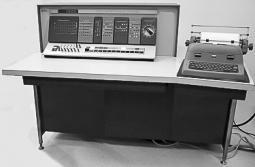Polio Place
A service of Post-Polio Health International
Artifacts
IBM 1620 Model 1 Scientific Computer
Joe Drogan; Atlanta, Georgia
Upon graduating from high school I began to worry about how I’d make a living in the real world as a polio survivor. I was a decent car mechanic but realized it would be a lifelong challenge to work in that physical of a profession. A doctor at Shriners Hospital for Crippled Children had said I was the most ingenious person he’d ever met. I could have created tools that would have helped me do the work, but it still was probably not the ideal career choice.
In September 1967, my first semester in college, I first encountered the IBM 1620 computer. It had 20,000 decimal positions of memory. Your TV remote probably has a million times that. My task was to learn to program it. Even programming computers was physically challenging with a polio damaged right arm and hand. I wondered if I’d be up to the task. I soon learned, however, that in programming, accuracy is far more important than typing speed. That began a lifelong understanding that we are mostly limited by what we think we can’t achieve. Thank God for that. We now know that a physical job like mechanics would have taken a much greater toll on my body and made post-polio syndrome much worse for me now. Had it not been for a lifelong love of computers that began with the IBM 1620 Model 1 and that continues today, who knows how I’d have ended up?


















































